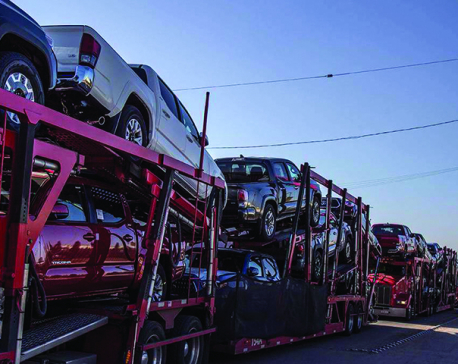
OR


Prakash Amatya
The author is a development practitioner involved in Safe Water and Sanitation programsnews@myrepublica.com
More from Author
One in three persons in the world lives without a decent toilet, which means much fecal waste is not safely dealt with
Beijing hosted a unique business expo on reinvented toilet in the first week of November. Bill Gates, Co-Chair of Bill and Melinda Gates Foundation, was hosting the Reinvented Toilet Expo to commercialize futuristic toilets that don’t need water or sewers. Bill Gates stunned the crowd in Beijing with a jar of human feces in his hand.
“Can’t stop thinking about that moment when Bill Gates brought poop to the podium during his great speech on “New” toilet revolution at #ReinventedToilet Expo in Beijing, China,” recalled Bipin Dangol, Executive Director at Environment and Public Health Organization. He witnessed not only the 20 different innovative toilets in the expo that will change the definition of the toilet but saw the solutions that will bring a big change in public health.
The management of human waste needed a paradigm shift. The 19th century sanitation solutions in cities of Europe are fast becoming outdated, prohibitively expensive to maintain, and rely too much on water.
Still one in three persons in the world lives without a decent toilet, which means too much fecal waste is not safely dealt with. This negligence to right to water and sanitation results in death of a child under five every two minutes. Gates is right that the global sanitation problem will get worse if we don’t do something about it.
Gates urged in his speech, “Today, rich countries have a sewage system where you bring water in, put the human waste in it and it goes out to all the way to a treatment processing plant. That requires the installation of a lot of pipes. It’s very expensive and it’s not going to happen in these newer, poorer cities.”
Dr Doulaye Kone mentioned that the era of innovation in the toilet has come. On May 24, 120 experts from 33 countries met on top of the world, in Nepal and approved a new standard ISO 30500 that set requirements for toilets that kill pathogen, and do not produce any waste. During the expo, we saw many different models of innovative public toilets.
A delegate comprised of officials from the government, development agencies, scientists, civil society and private business representatives from Nepal participated in this expo. Though the minister for water supply had to cancel her trip at the last minute, Nepal team made a significant presence and contributed in the high level panel. Sunil Kumar Das, Deputy Director at the Department of Water Supply and Sewerage Management, said that it’s right time for Nepal to adopt new system and technologies for safe and sustainable sanitation. The next generation toilet is onsite sanitation and it’s the only way to recover the resources.
We have to collaborate with the scientists, development partners and the private sectors to skill transfer and promote the new #reinvented toilet technologies.
Bhim Upadhaya, former Secretary to the Ministry of Water Supply, opined that the science and engineering never thought of toilets beyond pan and commode but this expo highlighted the importance of the holistic approach of the toilet. The innovative toilet products in the expo were amazingly reengineered. It’s not only the toilet solutions but brings a massive opportunity for the business to Nepal. Nepal cannot ignore the fecal waste management and it should address it with priorities to bring sustainable development and prosperity.
But technology alone cannot serve the purpose. We need to have a favorable policy environment and that can come only with political commitment. If we fail to bring private business actors in the market of reinvented toilet solution, we won’t be able to take this initiative forward.
The dream for an ideal toilet that kills 100 percent pathogens, uses minimum water, and produces resources such as energy, clean water, and fertilizers has come true. It’s possible to bring in new toilets and bid farewell to the old ones which consume much water.
It’s up to the government how to tap this solution and create healthy and hygienic Nepal. It has much to do to move forward toward that direction.
The author is a development practitioner involved in Safe Water and Sanitation programs
You May Like This

Spain’s political paralysis
Many in Madrid say that Spanish politics is becoming Italian, only without the Italians’ feats of political gymnastics ... Read More...

Mayday for protectionism
Whereas America built less than one million gross tons of ships between 2014 and 2016, South Korea and China produced a... Read More...

Genealogy of xenophobia
In a country burdened by ethno-nationalism, self-destructive jingoism and hubristic self-importance, the politics of prosperity is merely a façade... Read More...

Just In
- Over 200,000 devotees throng Maha Kumbha Mela at Barahakshetra
- Indians vote in the first phase of the world’s largest election as Modi seeks a third term
- Kushal Dixit selected for London Marathon
- Nepal faces Hong Kong today for ACC Emerging Teams Asia Cup
- 286 new industries registered in Nepal in first nine months of current FY, attracting Rs 165 billion investment
- UML's National Convention Representatives Council meeting today
- Gandaki Province CM assigns ministerial portfolios to Hari Bahadur Chuman and Deepak Manange
- 352 climbers obtain permits to ascend Mount Everest this season






_20220508065243.jpg)











Leave A Comment